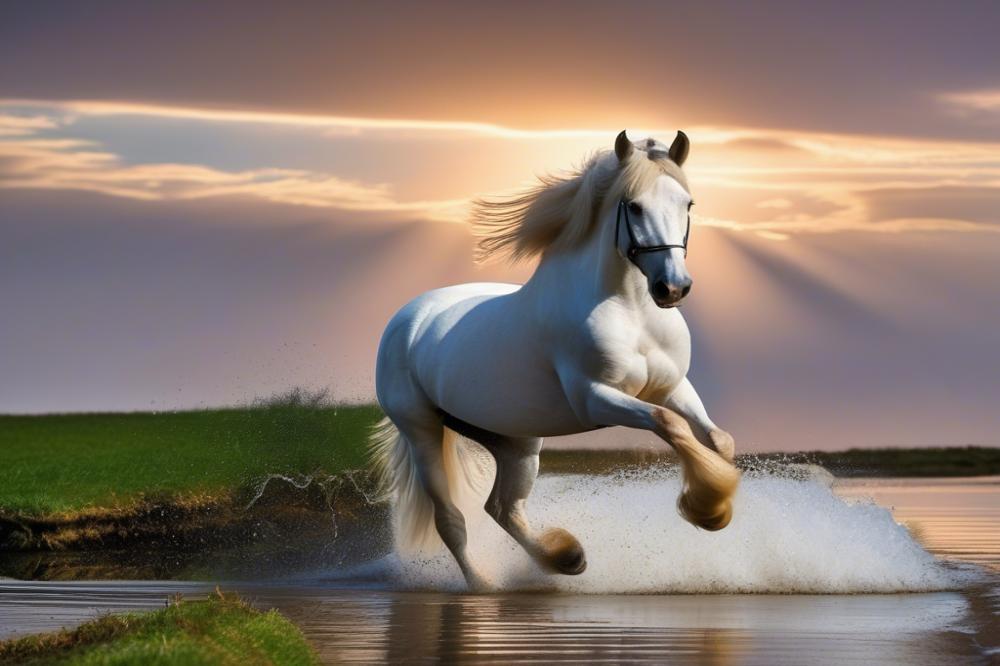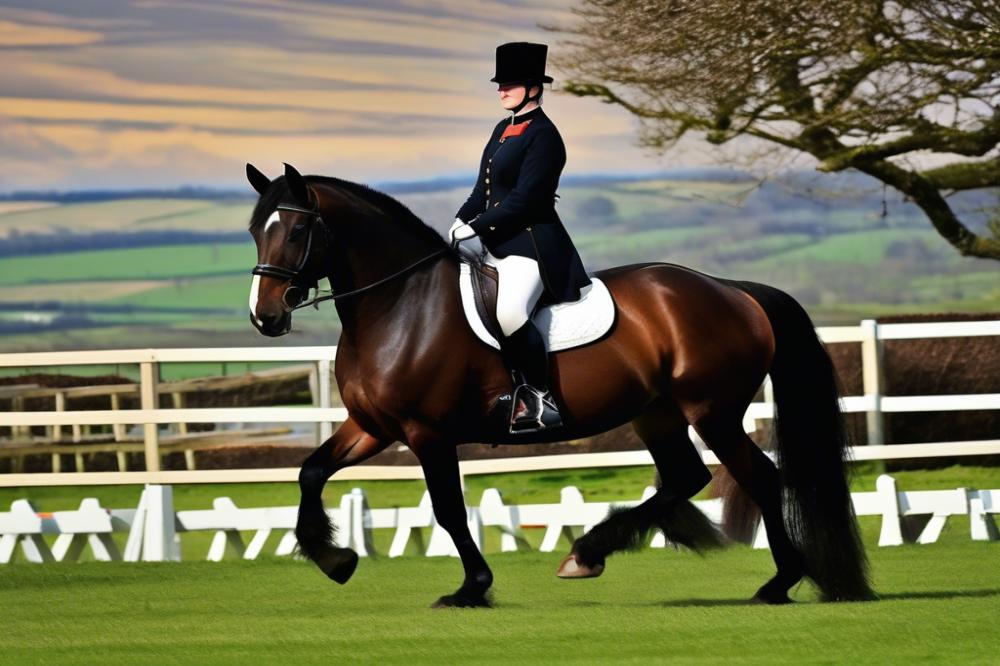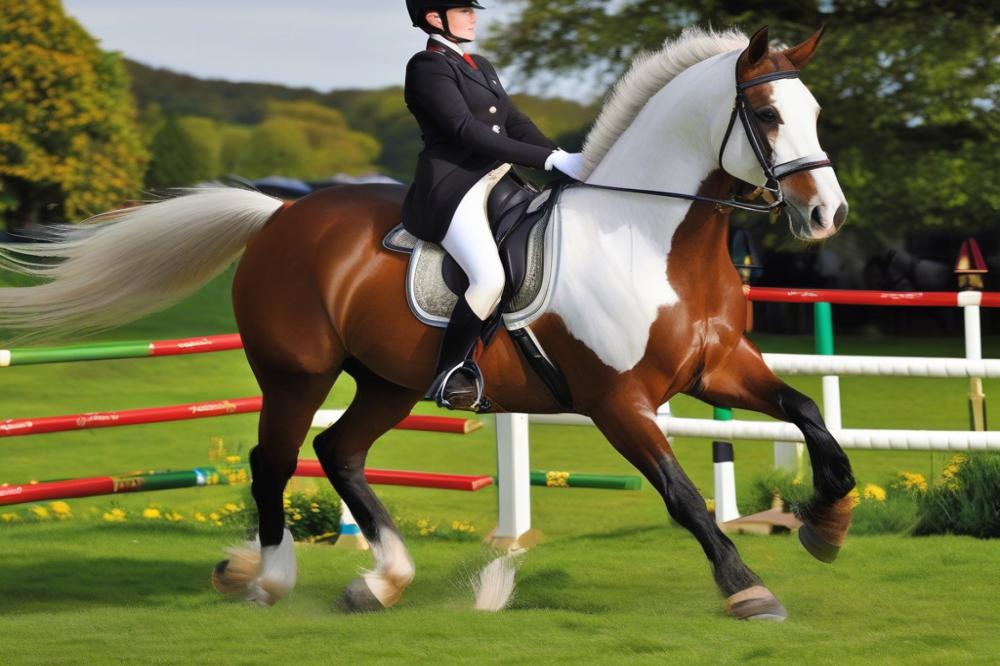Introduction
The Irish Draught Horse is cherished for its strength and agility. These horses are not only known for their beauty, but they also excel at jumping. Their well-balanced build gives riders confidence when taking on obstacles. Riders seeking to develop their skills in jumping will find this breed particularly suitable.
Understanding riding methods is crucial for success. Techniques can make the difference between a smooth jump and a challenging one. Learning about posture, balance, and timing is essential for any rider. Knowledge of jumping techniques allows equestrians to connect better with their horse, leading to more effective communication.
This article aims to share secrets that will help riders improve their jumping abilities. Readers will find valuable insights into handling the Irish Draught Horse. The information presented can enhance both confidence and performance. With practice and dedication, any rider can master the art of jumping with this remarkable breed.
Understanding the Irish Draught Horse

Characteristics of the Breed
The Irish Draught is a robust and versatile horse. This breed stands out due to its strength and agility. Muscles are well defined, offering both power and balance. Their height typically ranges from 15.2 to 16.3 hands, making them suitable for various riders. The coat comes in various colors, including gray, bay, and chestnut. Their build allows for a graceful yet strong presence, making them appealing to equestrians.
Strengths in Jumping and Equestrian Sports
Jumping is where the breed truly shines. Many riders appreciate their ability to take on tough courses with confidence. Not only do they possess great stamina, but they also have excellent jumping mechanics. Their natural talent makes them ideal for both beginners and advanced riders. Many successful show jumpers have roots in this breed. Their willingness to work and learn is commendable. They often adapt well to different types of equestrian sports.
Horse Behavior and Temperament
Understanding horse behavior is crucial for any rider. The Irish Draught is known for its calm and gentle demeanor. Riders often find them easy to train and handle. Intelligence plays a big role in their learning ability. Being sensible and reliable, they tend to approach new situations with caution. They often bond well with their riders, creating a strong partnership. This breed’s temperament is often described as friendly and patient. For many, these traits make them perfect companions in the arena or out on the trails.
Essential Riding Skills for Jumping

Successful jumping requires a solid foundation of horse riding techniques. Riders must develop a deep understanding of their own body mechanics. Correct posture allows for better communication with the horse. Maintaining a relaxed yet alert demeanor is essential because tension can transfer to your mount. Flexibility in your legs and core supports effective movement during jumping.
Fundamental horse riding Techniques
Starting with basic riding skills helps to build confidence for more complex maneuvers. Riders should practice maintaining a steady rhythm while trotting and cantering. Having control over speed is crucial, especially when approaching a jump. Directing the horse’s energy toward the jump prevents last-minute hesitations. Additionally, riders need to be conscious of their grip on the reins and the saddle, ensuring their hands remain steady but not rigid.
Positioning and Balance for Effective Jumping
Well-timed positioning can make or break a jump. A good jumping position includes leaning slightly forward while keeping the upper body balanced. The legs should drape around the horse, with heels down and toes up. Transfer of weight must happen naturally. Riders should visualize the upcoming jump to prepare mentally. This mental image will aid in maintaining focus during the approach.
Common Mistakes to Avoid During Jumping Exercises
Over-anticipating the jump frequently leads to errors. Many riders lose their balance by standing up too early. Leaning backward can also cause the horse to misread the jump. Avoid gripping with the knees; this can restrict the horse’s movement. It’s important not to pull on the reins too hard during the jump, as this can create tension. Proper timing is vital: waiting for the right moment to go with the horse ensures a smooth takeoff.
Training Tips for Jumping Success

Developing a Training Regimen Tailored to Irish Draught Horses
Training these horses requires understanding their strengths and weaknesses. Start by assessing the horse’s current skill level. Tailor your regimen to build on what they know while gently introducing new challenges. Incorporate varied exercises to keep the horse engaged. Warm-up sessions should focus on flexibility and responsiveness. Remember, repetition is key, but so is variety. Gradually increase the intensity of workouts. This helps maintain interest and avoid fatigue. Engaging in cross-training can also be beneficial. It develops different muscle groups and keeps the experience fresh.
Incorporating Jumping Form and Technique into Training
Focusing on form is vital for successful jumping. Riders should work on maintaining a correct position while jumping. The horse must learn to lift its legs effectively to clear obstacles. Begin with ground poles and small fences to establish confidence. Use cone markers to guide the path and encourage straightness. Video recordings of sessions can be useful too. Watching footage helps identify areas for improvement. Consistent practice of flatwork also enhances jumping techniques. When riders feel secure, they can progress to more complex exercises. Ensure every jump is a learning moment, reinforcing good habits.
Exercises to Improve Horse and Rider Coordination
Coordination between horse and rider forms the foundation for safe jumping. Incorporate lateral movements into the routine. This helps both horse and rider work together more effectively. Simple exercises, like circles and figure-eights, establish communication. A rider’s body language plays a large part here. Clear signals guide the horse through the course. Set up exercises that require quick changes of direction to improve responsiveness. Jumping grids are helpful tools for enhancing rhythm and coordination. These grids teach the horse to measure strides while improving timing. Practice together consistently to build trust and harmony in your partnership.
Preparing for Competition Readiness
Assessing Horse’s Readiness for Show Jumping
Before heading to a show, it’s important to evaluate your horse. Look for signs of physical fitness. A proper warm-up routine can reveal a lot. Is your horse eager to work? Check their energy levels and willingness to engage. Observe their jumping style during practice. A horse that jumps with confidence is generally a good sign. If your mount seems hesitant, adjustments might be necessary before competition day.
Routine Practices Leading Up to Competition
Develop a consistent training schedule in the weeks leading to the event. Daily exercises should include a mix of flat work and jumping drills. Incorporate varied courses to mimic show conditions. This helps the horse adapt to different heights and angles. Long rides help build stamina, while shorter, intense sessions increase focus. Consider including ground poles and gymnastic exercises in practice sessions. These elements can enhance both technique and coordination.
Mental Preparation for Both Horse and Rider
Mental readiness is just as critical as physical training. Spend time bonding with your horse before the competition. A calm relationship can make a significant difference in performance. Visualize the course and potential challenges. Picturing success may help ease anxiety. Riders should also develop a calming routine. Breathing techniques can reduce nerves and improve focus. Remember, a relaxed horse often leads to a more successful ride. Encourage positive energy and confidence as you both prepare for jumping.
Equine Care for Jumping Horses
Proper care is crucial for performance horses. These animals carry the weight of their riders every day and require specific attention to thrive. Slight changes in their environment or routine can significantly impact their performance. That’s why maintaining their health is not just beneficial; it’s essential.
Nutrition and Health Considerations for Irish Draughts
Feeding a horse adequate nutrition is key to their well-being. A balanced diet supports energy levels, muscle development, and overall health. It’s wise to consult with an equine nutritionist. This can help determine the right mix of grains, hay, and supplements. High-quality hay and forage are particularly important. They provide the roughage necessary for effective digestion. Ensure water is always fresh and available as well. Staying hydrated plays a vital role in every horse’s performance.
When it comes to health, regular veterinary check-ups should be standard practice. Vaccinations and parasite control are important components of a robust care routine. Monitoring weight can also aid in identifying potential health issues. A horse that is too heavy or too light may struggle during competition.
Maintaining Hoof and Muscle Health
Hoof care should never be overlooked. Regular trimming and shoeing are essential for the comfort of any jumping horse. An untrimmed hoof can lead to lameness and performance issues. Your horse’s farrier can provide guidance on shoe choices best suited for jumping. Proper hoof care supports balance and agility during jumping events.
Muscle health is equally vital. Strengthening exercises can improve muscle tone and durability. Stretching before and after rides helps prevent injuries. Building muscle takes time and consistency, so patience is important. Different training regimens can promote strength and flexibility. Always listen to your horse’s body language. A horse that seems fatigued may need extra rest.
Final Thoughts
In summary, we’ve explored several important aspects of jumping with this remarkable breed. Riders should always focus on building a strong connection with their horse. This relationship is crucial for success in competitions and training sessions. Understanding the horse’s natural abilities and temperament can greatly improve performance. Ensure that proper groundwork and groundwork exercises are prioritized. These are key to developing confidence and trust.
Bringing an Irish Draught into your equestrian journey can be a truly rewarding experience. Each ride offers a new learning opportunity, and forming a bond with your horse is immensely fulfilling. Embrace the ups and downs that come with horse riding. Each challenge faced together helps strengthen the partnership between rider and horse.
As you step into the show jumping arena, remember the joys that this sport brings. High jumps and clear rounds can certainly be exhilarating. However, the real joy often lies in the hours of practice and the growth you experience along the way. Cherish the moments of triumph along with the lessons learned from setbacks.
Ultimately, the journey with an Irish Draught will leave lasting memories. This breed offers a unique blend of power and grace that makes every ride exciting. So saddle up, keep your spirit high, and enjoy the ride. The adventure in show jumping awaits!



